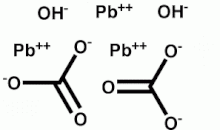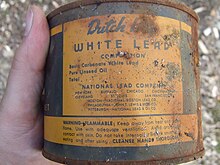What Is Another Word For Oil In Makeup
 | |
| Names | |
|---|---|
| Other names Basic lead carbonate | |
| Identifiers | |
| CAS Number |
|
| 3D model (JSmol) |
|
| ChemSpider |
|
| ECHA InfoCard | 100.013.901 |
| EC Number |
|
| PubChem CID |
|
| UNII |
|
| CompTox Dashboard (EPA) |
|
| InChI
| |
| SMILES
| |
| Backdrop | |
| Chemical formula | 2PbCO3·Atomic number 82(OH)ii |
| Molar mass | 775.633 chiliad/mol |
| Appearance | White powder |
| Hazards | |
| Occupational safety and health (OHS/OSH): | |
| Main hazards | Lead poisoning |
| GHS labelling: | |
| Pictograms |    |
| Hazard statements | H302, H332, H360, H373, H410 |
| Precautionary statements | P201, P202, P260, P261, P264, P270, P271, P273, P281, P301+P312, P304+P312, P304+P340, P308+P313, P312, P314, P330, P391, P405, P501 |
| Except where otherwise noted, data are given for materials in their standard state (at 25 °C [77 °F], 100 kPa). | |
| | |
| Infobox references | |

Color pigments used on the warship Vasa, with white pb second from left, bottom shelf.
White lead is the bones lead carbonate 2PbCO3·Lead(OH)2.[ane] It is a complex salt, containing both carbonate and hydroxide ions. White atomic number 82 occurs naturally as a mineral, in which context it is known every bit hydrocerussite,[i] a hydrate of cerussite.[2] Information technology was formerly used as an ingredient for lead paint and a corrective chosen Venetian ceruse, because of its opacity and the satiny smooth mixture it made with dryable oils. However, it tended to cause atomic number 82 poisoning, and its use has been banned in most countries.[3]
White lead compounds known as pb lather were also used as additive for lubricants for bearings and in machine shops.[iv]
History [edit]
What is usually known today as the "Dutch method" for the training of white lead was described equally early every bit Theophrastus of Eresos[5] (ca. 300 BC), in his brief piece of work on rocks or minerals, On Stones or History of Stones. His directions for the process were repeated throughout history by many authors of chemic and alchemical literature. The uses of cerussa were described as an external medication and pigment.[6]
Clifford Dyer Holley quotes from Theophrastus' History of Stones [7] equally follows, in his volume The Lead and Zinc Pigments.
Atomic number 82 is placed in earthen vessels over sharp vinegar, and later it has acquired some thickness of a sort of rust, which it usually does in about 10 days, they open the vessels and scrape it off, as it were, in a sort of foulness; they and then identify the atomic number 82 over vinegar again, repeating over and over again the aforementioned method of scraping it till it has wholly dissolved. What has been scraped off they then beat to powder and eddy for a long time, and what at last subsides to the bottom of the vessel is ceruse.[8]
Later descriptions of the Dutch process involved casting metal lead equally sparse buckles and corroded with acerb acid in the presence of carbon dioxide. This was done by placing them over pots with a little vinegar (which contains acerb acid). These were stacked up and covered with a mixture of decomposable dung and spent tanner's bark, which supplied the CO2, and left for six to fourteen weeks, by which time the blue-grey lead had corroded to white lead. The pots were and so taken to a separating tabular array where scraping and pounding removed the white lead from the buckles. The powder was then stale and packed for shipment or shipped every bit a paste.[9] I benefit of the process was that it was not necessary to dry the paste of white lead, removing its h2o. All that needed was to manufactory the paste with linseed oil, and the white lead would have up the oil and decline the residual water, to requite white lead in oil.[ commendation needed ]
Paints [edit]

Can of Dutch Boy Paint, consisting of basic atomic number 82 carbonate and linseed oil.
White lead has been the principal white pigment of classical European oil painting.[10] There take been claims that it is partly responsible for darkening of old paintings over time, reacting with trace amounts of hydrogen sulfide in the air to produce blackness pb sulfide. Other regime dispute this; the most traditional view is that impermanent pigments and dirty varnish (which is often cleanable) are more probable responsible for darkening.[ citation needed ]
Paintings and the part of varnish, which might protect the white atomic number 82 yet itself darken, aside—co-ordinate to Michelle Facini, a paper conservator at the National Gallery of Art, conversion of lead carbonate to lead sulfide is indeed what happens to some lead chalks/paints in drawings and watercolors and other works washed on newspaper and unvarnished. Varnish is meant to be removable from an oil painting, to strip off when it dirties or cracks; but on newspaper it soaks through and becomes inseparable from the paper fibers, ruinous as it ages. This is why works on newspaper are never, or should never be, varnished.[ citation needed ]
In any event, white lead has been mostly supplanted in artistic utilize past titanium white, which has much higher tinting strength than white atomic number 82.[11] Critics argue that substitutes similar zinc oxide and titanium dioxide are more reactive, become brittle, and can flake off.[12] [thirteen] White lead is less used by today's painters, not because of its toxicity directly; simply but because its toxicity in other contexts has led to trade restrictions that make white lead difficult for artists to obtain in sufficient quantities.[14] Winsor & Newton, the English pigment visitor, was restricted in 2014 from selling its fleck white in tubes and at present must sell exclusively in 150 ml (5.three imp fl oz; 5.i US fl oz) tins.[xv]
In the eighteenth century, white lead paints were routinely used to repaint the hulls and floors of Purple Navy vessels, to waterproof the timbers and limit infestation by shipworm.[16]
Other synonyms (equally an art pigment) [edit]
Among the synonyms for white lead are Berlin white, Cremnitz white, Dutch white lead, flake white, Flemish white, Krems white, London white, Paint White 1, Roman white, silver white, slate white and Vienna white.[17]
Run across also [edit]
- List of inorganic pigments
- Venetian ceruse
- White Atomic number 82 (Painting) Convention, 1921
References [edit]
- ^ a b Wiberg, Egon; Holleman, Arnold Frederick (2001). Inorganic Chemical science. Elsevier. ISBN0-12-352651-five.
- ^ meet mineral hydration
- ^ Hernberg, Sven (September 2000). "Lead Poisoning in a Historical Perspective" (PDF). American Journal of Industrial Medicine. 38 (iii): 244–254. CiteSeerXx.1.ane.477.2081. doi:ten.1002/1097-0274(200009)38:three<244::AID-AJIM3>iii.0.CO;2-F. PMID 10940962.
- ^ Klemgard, E.Due north. (1937). "Lead base greases". Lubricating Greases Their Manufacture And Use. Reinhold Publishing Corporation. p. 677.
- ^ J. R. Partington, A Short History of Chemical science (1937)
- ^ Stillman, John Maxson (1924). The Story of Early Chemistry. D. Appleton. pp. xix–xx.
- ^ Theophrastus, History of Stones, p.223
- ^ Holley, Clifford Dyer (1909). The Pb and Zinc Pigments. John Wiley & Sons. p. 2.
- ^ Lead411.org based on Warren, Christian. "Toxic Purity: The progressive era origins of America'southward lead pigment poisoning epidemic". Business History Review. Winter 1999, Vol. 73(4)
- ^ "Stack Procedure White Atomic number 82 (Sometime Dutch Method)". Commercial supplier, offering original pigments to the conservation and reproduction markets
- ^ Laver, M. (1997). "Titanium Dioxide Whites". In Fitzhugh, Due east. W. (ed.). Artists' Pigments. Vol. 3. Oxford Academy Press. p. 309.
- ^ "Zinc White: Problems in Oil Pigment". The Smithsonian's Museum Conservation Plant exposes long-term bug with zinc white
- ^ Macchia, Andrea; Cesaro, Stella; Keheyan, Yeghis; Ruffolo, Silvestro; La Russa, Mauro (2015). "White zinc in Linseed Oil Paintings: Chemical, Mechanical and Aesthetic Aspects". Periodico di Mineralogia. 84 (3A): 483–495. doi:10.2451/2015PM0027.
- ^ Raine, Craig (5 September 2020). "Epic of gossip (review of The Lives of Lucian Freud : Fame 1968-2011 by William Feaver". The Spectator: 30/ii.
- ^ "Choosing a white in oil colour". Winsor & Newton . Retrieved eighteen October 2014.
For reasons of toxicity these Lead White colours are only available in tins in the European union.
- ^ Hough, Richard (1994). Captain James Cook. Hodder and Stoughton. p. 56. ISBN978-0-340-82556-three.
- ^ "Lead white". Conservation and Fine art Materials Encyclopedia Online (CAMEO). Museum of Fine Arts, Boston (Massachusetts). Retrieved 6 June 2019.
Farther reading [edit]
- Gettens, R.J., Kühn, H. and Chase, Due west.T. "Lead White", in Roy, A., (Ed), Artists' Pigments, Vol 2, Oxford University Press, 1993, pp. 67–81
External links [edit]
- Lead white, Colourlex
What Is Another Word For Oil In Makeup,
Source: https://en.wikipedia.org/wiki/White_lead
Posted by: keithbourfere.blogspot.com


0 Response to "What Is Another Word For Oil In Makeup"
Post a Comment